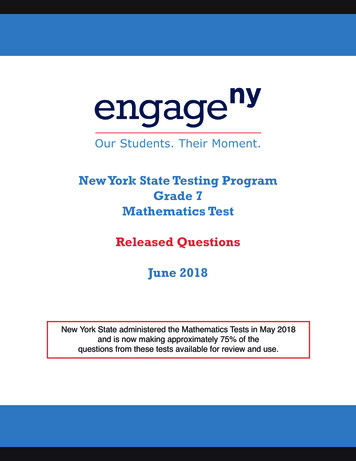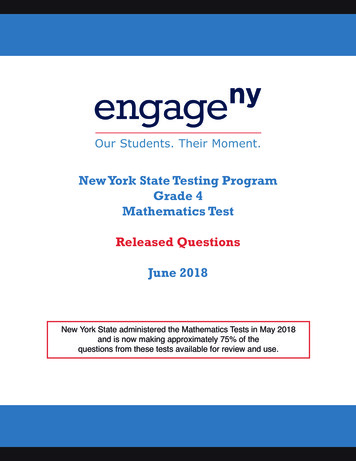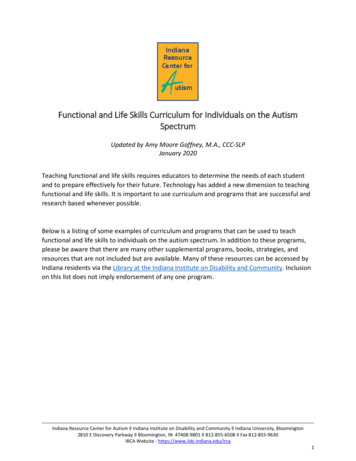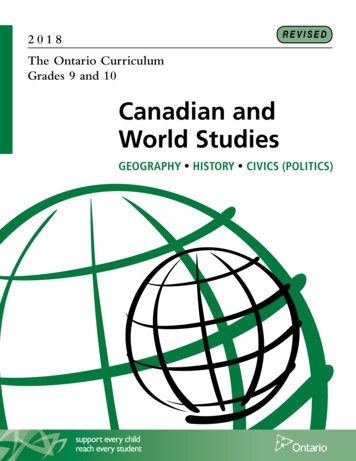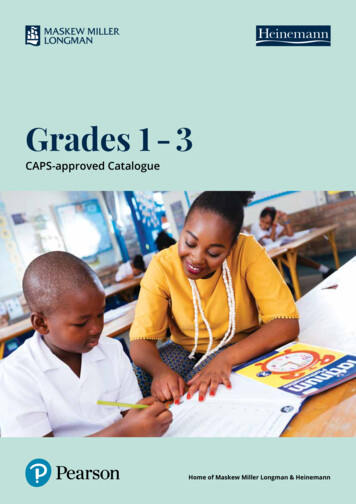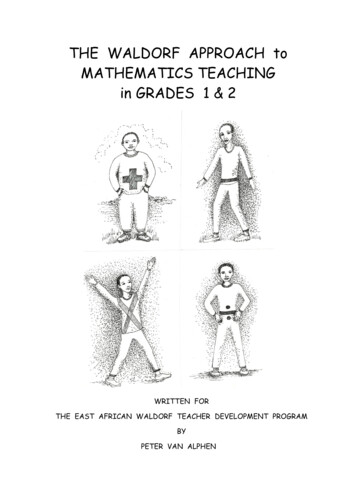
Transcription
THE WALDORF APPROACH toMATHEMATICS TEACHINGin GRADES 1 & 2WRITTEN FORTHE EAST AFRICAN WALDORF TEACHER DEVELOPMENT PROGRAMBYPETER VAN ALPHEN
2Open SourceThis series of manuals has been commissioned by Zukunfsstiftung Entwicklungshilfe, tosupport teacher development in East Africa. The manuals can be used in other trainingprograms, individual or group study, anywhere in the world, provided every page shows thesource and the open source registration, as it appears on the bottom of each page.The open source licence under Creative Commons (see www.creativecommons.org) allowsthe manuals to be downloaded and redistributed only for non-commercial purposes [thatmeans these manuals may never be sold].In addition, the licence permits the remixing, tweaking, translating or producing new workbased on the manuals, provided that all new work based on these manuals will acknowledgethe authors and source and carry the same license. This ensures that any derivatives will alsobe non-commercial in nature.The manuals can be downloaded from www.entwicklungshilfe3.deZukunftsstiftung EntwicklungshilfeChriststrasse 9D-44789 BochumGermanyTel. 49-234-5797-224/ -124Fax 49-234-5797-188AuthorPeter van AlphenIllustrationsCatherine van AlphenAcknowledgementsWhilst every effort is made to acknowledge the work of others included in this manual, it hasnot been possible to trace the authors of the poems or other material, handed down fromteacher to teacher. I ask that any information regarding authorship is passed on to me, onpeterva@mweb.co.za, so that authors may be acknowledged for their work in subsequenteditions/printings.Source: www.entwicklungshilfe3.de Open Source: Creative CommonsAttribution-Non-Commercial-Share Alike 3.0 International Licence; see www.creativecommons.org
3This manual is indebted to the Waldorf tradition of teaching according to the principles ofRudolf Steiner (1861 – 1925), as developed by many generations of teachers. I would like tomake specific mention of the late Yvonne Bleach, my colleague from Novalis Institute and theCentre for Creative Education (both in Cape Town) and from the Federation of WaldorfSchools in South Africa, who has done so much for the development of mathematicsteaching, and has been such an inspiring colleague in working together in the teaching ofmathematics. Yvonne taught in the East Africa training program in August 2008, and wasloved and admired by all the participating teachers.My thanks to:Ann Sharfman for the beautiful photograph of Yvonne Bleach on page 4.Shamima Wolmarans for finding the two quotations printed on page 7.Peter van AlphenThe East African Waldorf/Steiner Teacher DevelopmentProgrammeThe East African teacher development programme was started by the late Adeline Mlai, aTanzanian, in Dar-es-Salaam in 1997. Adeline recognised the developmental value ofWaldorf education and invited Peter van Alphen and Ann Sharfman, teacher educators withexperience working in African settings in Cape Town, South Africa, to start a teacherdevelopment programme in Dar-es-Salaam. This programme was set up for teachers fromTanzania, Uganda and Kenya.After the first year, difficulties securing the funds for continuing the programme wereexperienced, and in 1999 the programme was relocated to Nairobi, Kenya, as a more centralvenue for the three countries. The Rudolf Steiner School in Mbagathi was able to securefunding for its continuation, and in the eleven years that followed an ever-increasing number ofteachers from East African countries joined the programme.Our grateful thanks go to Zukunfsstiftung Entwicklungshilfe (Bochum, Germany) and Freundeder Erziehungskunst Rudolf Steiners (Berlin, Germany) for their continued support of theprogramme from 1999. We also wish to thank Sanduko a Ndege (Vejle, Denmark),Internationaal Hulpfonds (Amsterdam, Netherlands), Acacia (Basel, Switserland), StichtingHelias (Netherlands) and the Iona Stichting (Amsterdam, Netherlands) for their additionalsupport.About this ManualThis manual answers the need for teachers (or student-teachers) to have notes on themodules they attend. This manual is written for Primary School teachers doing the module onteaching mathematics in Grades 1 and 2, which follows on the second module of the programin which a detailed study of Rudolf Steiner’s concept of child development was given. Thesecond module included details of curriculum, to show how all teaching needs to grow out ofan understanding of the developmental stages of the children at each age. Teachers wishingSource: www.entwicklungshilfe3.de Open Source: Creative CommonsAttribution-Non-Commercial-Share Alike 3.0 International Licence; see www.creativecommons.org
4to use this manual are therefore asked to first study the manual on Child Development, so thateverything written here can be seen in the correct light.This manual is intended to guide teachers through the difficult task of teaching Mathematics inGrades 1 and 2.This manual is intended to be handed out at the end of the module for revision and furtherstudy. The suggestion is that participants study together in groups in their respective schools.We trust that the material provided will be useful in Waldorf training programmes in manycountries around the world. Comments and suggestions are welcomed, and can be sent toPeter van Alphen on peterva@mweb.co.za.This manual is dedicated to the memory ofYVONNE BLEACHWaldorf teacher and teacher-trainer, whose work in the teaching of Mathematics hasenlightened and inspired countless teachersSource: www.entwicklungshilfe3.de Open Source: Creative CommonsAttribution-Non-Commercial-Share Alike 3.0 International Licence; see www.creativecommons.org
5THE WALDORF APPROACH TOMATHEMATICS GRADES 1 - 2INDEXLEARNING READINESS for MATHEMATICS . 8MOVEMENT IN THE UNIVERSE . 12OUTER MOVEMENT TO INNER MOVEMENT . 12THE MAIN LESSON SYSTEM . 15Main Lesson Blocks . 16Structure of a Main Lesson . 17GRADE 1NUMBER RECOGNITION . 21COUNTING . 24COUNTING BACKWARDS . 30WORKING WITH COUNTERS . 33MULTIPLES AND TABLES . 35COUNTING IN MULTIPLES : . 37LEARNING THE TABLES . 42THE FIRST MATHS MAIN LESSON BLOCK . 45QUALITY OF NUMBERS. 48BONDS . 57HOLISTIC TEACHING OF MATHEMATICS . 60THE FOUR OPERATIONS . 64Preparation for the Four Operations . 64Introducing the four operations . 65Working from the whole to the parts in the operations . 67Creating story-sums . 68The Three-Day Lesson Plan For Introducing Each Operation . 69The DO-SAY-WRITE procedure . 71Guidelines for this main lesson. 72Practice Lessons . 75rd3 & 4th MATHS MAIN LESSON BLOCKS . 76GRADE 2Source: www.entwicklungshilfe3.de Open Source: Creative CommonsAttribution-Non-Commercial-Share Alike 3.0 International Licence; see www.creativecommons.org
6GRADE 2 . 79COUNTING . 80BONDS . 81MULTIPLES AND TABLES . 83MENTAL ARITHMETIC . 89COUNTERS . 90THE FOUR OPERATIONS . 91EXTENDED N0TATION. 93THE MATHS MAIN LESSON BLOCKS . 100VERTICAL SUMS . 101THE COMMUTATIVE LAW . 111THE NUMBER ‘0’. 112NUMBER PATTERNS. 113Source: www.entwicklungshilfe3.de Open Source: Creative CommonsAttribution-Non-Commercial-Share Alike 3.0 International Licence; see www.creativecommons.org
7The prime value of learning mathematics is that it develops our thinking, ourreal, willed, independent thinking; a thinking capable of directing its powersin cognising both the material world and the invisible world within.Rudolf Steiner.The aim of every teacher of Mathematics is to bring about a confidentcapacity in his or her pupils to be able to move freely within a particulartopic which is being focussed upon, be it the life of number, the emergenceof geometrical form and its metamorphoses, or the application ofmathematical ways of thinking to practical situations and technical tasks inthe world.Ron Jarman.Source: www.entwicklungshilfe3.de Open Source: Creative CommonsAttribution-Non-Commercial-Share Alike 3.0 International Licence; see www.creativecommons.org
8LEARNING READINESS for MATHEMATICSIn Waldorf Education great emphasis is laid on children’s learning readiness beforethey are taught to learn mathematics in a formal way. Physical development,emotional and social development, as well as intellectual development all need greatcare in the years before the child turns 7.However, the primary school teacher needs to understand all these developments, as there may be children in her or his class that have not gone to a well developedWaldorf kindergarten, and therefore need to do catching up even if there is a well-developed Waldorf kindergarten, there may be childrenwho are slow in their development, or have missed certain steps in theirdevelopment, who need to do catching up and equally important, the primary teacher needs to build on thesedevelopments in order for the children to be able to learn mathematics well.The foundations for Mathematics lie in the years from birth to about 7 years. Thissection will explain the particular developments that are needed for children to learnMathematics, and exercises which the teacher can use as a part of every day’slessons.PHYSICAL DEVELOPMENTThe life forcesWe need to understand that the physical body consists of two parts: the physical body(our “flesh and bones”) and the ‘body’ of ‘life forces’ or ‘formative forces’ (also calledetheric forces) that brings life and development to the physical body. These life forcescannot be seen with our physical eyes, but they are present in the body, keeping thebody functioning correctly. At death, these life forces leave the physical body, and sothe body stops functioning and gradually decays.In the first 7 years of a child’s life, the life forces are very strong and very active. Theyhave a great deal of work to do, because at birth the baby is not ready to live as we doon the earth: a lot of growth has to take place. The organs of the body need to bedeveloped further to be able to function as humans do. The most importantdevelopments take place in the brain, so that the child can bring her or his body undercontrol, can use all the senses well, and can learn to think.During the first 7 years of life, parents and teachers need to care for these life forcesas they need to do their work in building, developing and refining the body, so that it isfully able to meet life in our world. This means that they may not make academicdemands on the child during this time, because the life forces would then be takenaway from their work on the body.Source: www.entwicklungshilfe3.de Open Source: Creative CommonsAttribution-Non-Commercial-Share Alike 3.0 International Licence; see www.creativecommons.org
9Academic learning demands memory and a formal way of thinking, using up life forcesthat are needed to grow, develop and refine the physical body. The results ofexpecting academic learning before about 7 years of age are a weakening of thephysical body, and later in life more easily getting serious diseases, such as nervousdisorders. It can also cause ‘burn-out’, even in young children.The child’s body gives us signs of when the life forces have completed their work.One of the main signs is the changing of teeth. The front teeth start changing before 7years, but it is only when the first sixth tooth (counting from the middle of the teeth tothe side - a molar) appears, that we can be sure that the process of developing thebody has been completed.This tells us that part of the life forces remain to keep the body growing, healthy andfunctioning all the time, and that part has been freed from the body, to be used for anew step in learning. Many of the other teeth will keep changing after the first sixthtooth appears, for some years afterwards.When we consider the work of the life forces, we can see how important it is thatchildren enter Grade One having turned 6 years of age, therefore turning 7 yearsduring Grade One.MovementWhen a child is born, it is not ready for living on earth. Everything has to be learnt, andthe child’s main way of doing this is through movement and imitating the movements ofothers. From moving the hands, to turning the body, to crawling and standing, thechild gradually learns to walk. Speaking also is movement: the vocal cords have tovibrate, the tongue, mouth and lips all need to learn many different movements to formthe different sounds.All movements have a direct connection with the brain: The brain needs to develop its synapses (connections between brain cells)through learning many, many movements (eye muscles, speech muscles, largemotor and fine motor co-ordination, eye-hand and eye-foot co-ordination,uprightness, crawling, walking, running, balancing, crossing the mid-line, etc) These synapses are the basis for thinking - without the formation of thesesynapses, through learning to move the body in a great number of ways,thinking is not possible The organs of the body need to form themselves so that the body can live in itsenvironmentHere we see again how the body has to be prepared during this time through manydifferent forms of movement, causing the brain to develop, before formal learning canSource: www.entwicklungshilfe3.de Open Source: Creative CommonsAttribution-Non-Commercial-Share Alike 3.0 International Licence; see www.creativecommons.org
10begin. Again we can see the importance of waiting till the child turns 7 years beforestarting learning to write, read and do arithmetic (Maths).EMOTIONAL DEVELOPMENTA child needs to be a happy person to be able to learn. Self-confidence, a wellbalanced emotional life and an energetic will should have been developed during theyears from birth to about 7 years. Lacks in these areas may block a child’s ability tolearn, and the primary teacher needs to observe the emotional maturity of childrencarefully when they join primary school.SOCIAL DEVELOPMENTIn a well-developed Waldorf kindergarten, plenty of opportunity is given to developingsocial behaviour between children, and between children and adults. As much ofmathematics learning is done in whole class work, group work and working in pairs,well-developed social skills will help the teacher enormously.INTELLECTUAL DEVELOPMENTOnce the life forces are freed, the teacher can begin to develop intellectual thinking inthe child. This means the development of: the ability to imagine (make pictures in the mind); this can be developed bytelling, rather than reading, stories to the child, imaginative teaching, drawingand painting the ability to sequence ideas (being able to put thoughts into logical order); thiscan be developed by recalling stories in the correct sequence, counting,challenging children by giving two or three instructions together and asking themto carry them out in the right sequence, the playing of ring games and countinggames memory, which is especially developed by the learning of counting and tables,many songs and verses, recalling stories thinking, rather than merely repeating what the teacher has said; this can bestimulated by discussion between teacher and class, by teacher getting childrento discuss in class (teacher making sure everyone listens to the child that isspeaking); teacher presenting lesson material that has depth and gets childrenthinking beyond everyday life. The idea is not to ask questions to get clever,analytical answers, but rather “feeling-thinking” responses suitable in this age ofchildhood.Source: www.entwicklungshilfe3.de Open Source: Creative CommonsAttribution-Non-Commercial-Share Alike 3.0 International Licence; see www.creativecommons.org
11Although the life forces have been freed for learning, we have to still take great care ofthem. Everything the child learns needs to be presented in an imaginative way,because between the ages of 7 and 14 years the child is in the feeling, dream-like,imaginative phase and not yet ready for ‘dry’, abstract learning.We have to take great care how we teach, so that we do not “rob” the child of exactlythose forces that give her or him energy and aliveness. This can be done by teachingimaginatively, by means of stories, images, poems, songs and little drama exercises.In fact, the imagination stimulates the life forces and avoids children getting tired orbored.The big danger is that teachers start teaching in a ‘direct’ way (the way many of ushave been taught in the old, traditional style) which has a “deadening” effect on thechild. It is like giving the child stones to eat, instead of the living grain which wouldenergise and strengthen her or him.Imagination is this living grain, because it leaves children free to picture everything intheir own way. Using the imagination and the different arts (music, movement, poetry,drama, painting, drawing and modelling) is a natural way of learning for children at thisage, and brings about well-being and aliveness.Source: www.entwicklungshilfe3.de Open Source: Creative CommonsAttribution-Non-Commercial-Share Alike 3.0 International Licence; see www.creativecommons.org
12MOVEMENT IN THE UNIVERSEMovement is everywhere in us and around us. This movement is rhythmical, and weas humans constantly experience this within our bodies (heart beat, breathing, walking,etc.) and within our daily lives (day and night, the seasons, the tides of the sea, etc.).The earth, moon and planets are continually moving around the sun, which is our star.The sun is also moving as part of the galaxy that we belong to. The entire universe,however far we go, is always moving.The Ancient Greeks spoke of the whole of creation as mathematical in its structure andmovement. Everything in creation works according to harmonious and rhythmicalinterrelationship between numbers.They also saw mathematics as having two faces : on the one hand Arithmetic, whichhas the word “rhythm” within it and has to do with numbers moving rhythmically in time,and Geometry which is numbers expressing themselves in space. “God geometrises,”said Plato.The Greeks therefore saw the whole of creation as a result of the work of numbers inboth time and space, and that all life within it moves in continuous harmony and order.We have to get the child to experience number-relationships in both time and space.Therefore arithmetic and geometry have to be given equal attention throughoutschooling.OUTER MOVEMENT TO INNER MOVEMENTThe child has mathematics in and around her or him in every way. However, this isexperienced unconsciously in the body and the senses. In order to build this bodilyknowledge of numbers, we do as much movement with children as possible: walking running crawling jumping (on and off things, or across things) climbing rolling throwing and catching swimming bean bag exercises gamesSource: www.entwicklungshilfe3.de Open Source: Creative CommonsAttribution-Non-Commercial-Share Alike 3.0 International Licence; see www.creativecommons.org
13To this, the teacher needs to add plenty of balancing exercises. One idea is to createa ‘balancing trail’ every morning before school begins, where children need to walk onlow garden walls, jump from one log to the next, walk on fallen tree trunks, walk on aline drawn on the pavement, rock on balancing boards and finally walk over abalancing beam as they enter the classroom. Apart from improving their sense ofbalance, these exercises are especially good for building awareness of space (in otherwords, geometry).Rhythmic movementTo lay a more direct foundation in the body for learning mathematics, the teacher doesa lot of rhythmical movement with the children which challenges them to strongly directtheir movements. They are challenged to be accurate in their movements, flowing intime to the rhythm.In this way they consciously experience number-relationships at work using the body.If the body knows number relationships, then it is possible to build concepts ofnumbers (that means, to understand numbers and how they work). Examples of theseactivities are: Simple, little traditional dances (the children can sing the tune while they dance) Moving to songs or poems that have a strong underlying rhythm1: short-short-long: (a dancing rhythm)- - — - - — - - —Let us dance to the rhythm of flute- - —- - —and of drum! Let us dance! long-short-short: (a falling rhythm, e.g. a waterfall)— - - — - - — - - —Whispering waterfall, why do you weep? short-long (a galloping rhythm)- — - — - — - —The horses gallop on the plain- — - — — - —Away they go and back again long-short (a swimming or paddling rhythm)— - — - — - — (-)Slowly swims the silent swan— - — - — - — (-)O’er the lake she rests upon—- — - — — (-)Through the mist and then she’s gone1These poems by Catherine van Alphen. Note: it is best to introduce one of these rhythms at a time, practising it till thechildren can do it fairly well, before introducing the next rhythm.Source: www.entwicklungshilfe3.de Open Source: Creative CommonsAttribution-Non-Commercial-Share Alike 3.0 International Licence; see www.creativecommons.org
14N.B. (-) is a silent ‘short’ Eurythmy, Bothmer, and other rhythmical movementLearning counting and tablesAdded to this, in order to learn mathematics more directly, the teacher will make upmany rhythmical ways of counting and learning the tables (see pages ), aswell as movement exercises in geometric patterns (see Movement for Learning bookletfor some examples).2 These approaches develop a living connection with the world ofnumbers, bringing much joy and awakening much interest in children towards learningmathematics.Keeping rhythmical movement alive and challengingRhythmic, purposeful movement needs to be practised on a daily basis, ideally duringthe main lesson time, or during one of the lessons that follow.The teacher needs to have a sense for progression, that is, to start simply and as theclass becomes good at a particular movement to make it more difficult, or to introduceanother movement exercise. As soon as the children show signs of doing themovements automatically or losing interest, it is a sign that it is time to change whatyou are doing with them, or how you are doing it with them. Making movements moreand more challenging keeps the body and senses awake and alive, stimulates thebrain to learn, so that new mathematical concepts are easily taken in.Using imagination, temperaments and bringing in plenty of variation also keep childreninvolved and interested in what they are doing. And most important of all, forsuccessful learning:Enthusiasm and joy of the teacher makes every child want to participate!The teacher needs to create enthusiasm and joy always, every lesson!Remedial workIf a child cannot learn counting or working with numbers, we have to take her or himback to catching up movements with his body that she or he has missed outdeveloping during early childhood. Crawling in particular may be needed, assometimes children miss this step in their early development. (See Movement forLearning booklet for suggestions)2The teacher can also give instructions such as “take 5 steps forward, 3 to the left, then 4 to the right”.Instead of steps, these could be bunny hops, kangaroo jumps, springbuck leaps, etcSource: www.entwicklungshilfe3.de Open Source: Creative CommonsAttribution-Non-Commercial-Share Alike 3.0 International Licence; see www.creativecommons.org
15Setting high expectationsIt is important to realise that movements have to be directed from the child’s innercentre, and not just be a weak imitation of the teacher’s movements. We thereforehave to demand consciously willed movement. This requires the teacher to watchhow individual children move in the group, to encourage - and expect - clear,decisive movement from each and every child (according to their ability).THE MAIN LESSON SYSTEMIn Waldorf Schools the first part of the day is considered to be the most valuable timefor children to learn new material. For this reason the first lesson is called the ‘MainLesson.’ Main Lessons are arranged in blocks of three weeks to handle a certaintopic (sometimes they can be two weeks, sometimes four weeks or longer, dependingon the topic).A Main Lesson block allows children to go into one topic in depth, by working on itevery day. The teacher deliberately plans his or her main lessons to attain this depth,by presenting the material to be learnt in an imaginative way, and by finding creative,playful ways of practising the new material learnt.The time of a Main Lesson is two hours, which may seem like a long time, but it ismade up of three parts, each part more-or-less 40 minutes in length, appealing to adifferent way of learning: The first 40 minutes: the ‘rhythmic’ or ‘feeling’ part, in which rhythmic movement(including the learning of counting, multiples and tables), and activities whichare rhythmic such as singing, speech exercises and speaking poetry, are done The second 40 minutes: the ‘content’ or ‘thinking’ part, in which the new materialto be learnt is presented (often by means of a story or image), leading tounderstanding the new material The last 40 minutes: the ‘task’ or ‘doing’ (or ‘will’) part, in which children areactively working on what they have learnt; the teacher finds creative tasks forthe children to consolidate the new material learnt.After the main lesson there is a break, followed by three 40-minute lessons (anotherbreak and more lessons from Grades 3 upwards) for a variety of purposes: Practice lessons, to practice language and maths skills2nd and 3rd language lessonsArtistic lessonsCraft lessonsGames lessonsSource: www.entwicklungshilfe3.de Open Source: Creative CommonsAttribution-Non-Commercial-Share Alike 3.0 International Licence; see www.creativecommons.org
16The weekly timetable for Grades 1 and 2 can look something like the following:MONDAYTUESDAYWEDNESDAY THURSDAY F
The child’s body gives us signs of when the life forces have completed their work. One of the main signs is the changing of teeth. The front teeth start changing before 7 years, but it is only when the first sixth tooth (counting from the middle of the teeth to the side - a molar) appear

